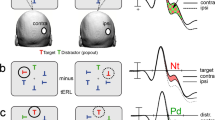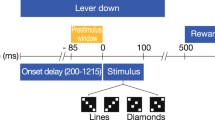Abstract
Empirical studies have demonstrated synchronized frontal and parietal electrophysiological signals at 22–34 Hz during a conjunctive visual search task and at 36–56 Hz during a pop-out visual search task. Bidirectional (conjunctive) versus unidirectional (pop-out) information transfer between neuronal populations is hypothesized to underly this difference in synchronization frequency. This study modeled the influence of connection type (i.e., unidirectional vs. bidirectional) on phase synchrony between two neural populations using a neural mass model. Phase-locking values (PLVs) were used as the measure of synchrony between populations. Consistent with the connectivity hypothesis, the model revealed greater PLVs at 22–34 Hz when the two populations were connected bidirectionally than unidirectionally, but greater PLVs at 34–52 Hz when connected unidirectionally than bidirectionally. The model suggests that inter-population connectivity also changes with bottom-up versus top-down control of attention.
Similar content being viewed by others
References
Bhattacharya J, Petsche H, Feldmanna U, Rescher B (2001) EEG gamma-band phase synchronization between posterior and frontal cortex during mental rotation in humans. Neurosci Lett 311: 29–32
Buschman TJ, Miller EK (2007) Top-down versus bottom-up control of attention in the prefrontal and posterior parietal cortices. Science 315: 1860–1862
Doesburg SM, Roggeveen AB, Kitajo K, Ward LM (2008) Large-scale gamma-band phase synchronization and selective attention. Cereb Cortex 18: 386–396
Lachaux JP, Rodriguez E, Martinerie J, Varela FJ (1999) Measuring phase synchrony in brain signals. Hum Brain Mapp 8: 194–208
Lopes da Silva FH, Hoeks A, Smits H, Zetterberg LH (1974) Model of brain rhythmic activity: the alpha-rhythm of the thalamus. Kybernetik 15: 27–37
Miltner WH, Braun C, Arnold M, Witte H, Taub E (1999) Coherence of gamma-band EEG activity as a basis for associative learning. Nature 397: 434–436
Phillips S, Takeda Y (2009) Greater frontal-parietal synchrony at low gamma-band frequencies for inefficient than efficient visual search in human EEG. Int J Psychophysiol 73: 350–354
Phillips S, Takeda Y (2010) Frontal-parietal synchrony in elderly EEG for visual search. Int J Psychophysiol 75: 39–43
Rodriguez E, George N, Lachaux JP, Martinerie J, Renault B, Varela FJ (1999) Perception’s shadow: long-distance synchronization of human brain activity. Nature 397: 430–433
Singer W, Gray CM (1995) Visual feature integration and the temporal correlation hypothesis. Annu Rev Neurosci 18: 555–586
Treisman AM, Gelade G (1980) A feature-integration theory of attention. Cognit Psychol 12: 97–113
Ursino M, Zavaglia M, Astolfi L, Babiloni F (2007) Use of a neural mass model for the analysis of effective connectivity among cortical regions based on high resolution EEG recordings. Biol Cybern 96: 351–365
Varela FJ, Lachaux JP, Rodriguez E, Martinerie J (2001) The brainweb: phase synchronization and large-scale integration. Nat Rev Neurosci 2: 229–239
Wendling F, Bartolomei F, Bellanger JJ, Chauvel P (2002) Epileptic fast activity can be explained by a model of impaired GABAergic dendritic inhibition. Eur J Neurosci 15: 1499–1508
Zavaglia M, Astolfi L, Babiloni F, Ursino M (2006) A neural mass model for the simulation of cortical activity estimated from high resolution EEG during cognitive or motor tasks. J Neurosci Methods 157: 317–329
Author information
Authors and Affiliations
Corresponding author
Rights and permissions
About this article
Cite this article
Takeda, Y. Influence of connection type on phase synchrony: analysis of a neural mass model. Biol Cybern 105, 349–354 (2011). https://doi.org/10.1007/s00422-011-0470-6
Received:
Accepted:
Published:
Issue Date:
DOI: https://doi.org/10.1007/s00422-011-0470-6




